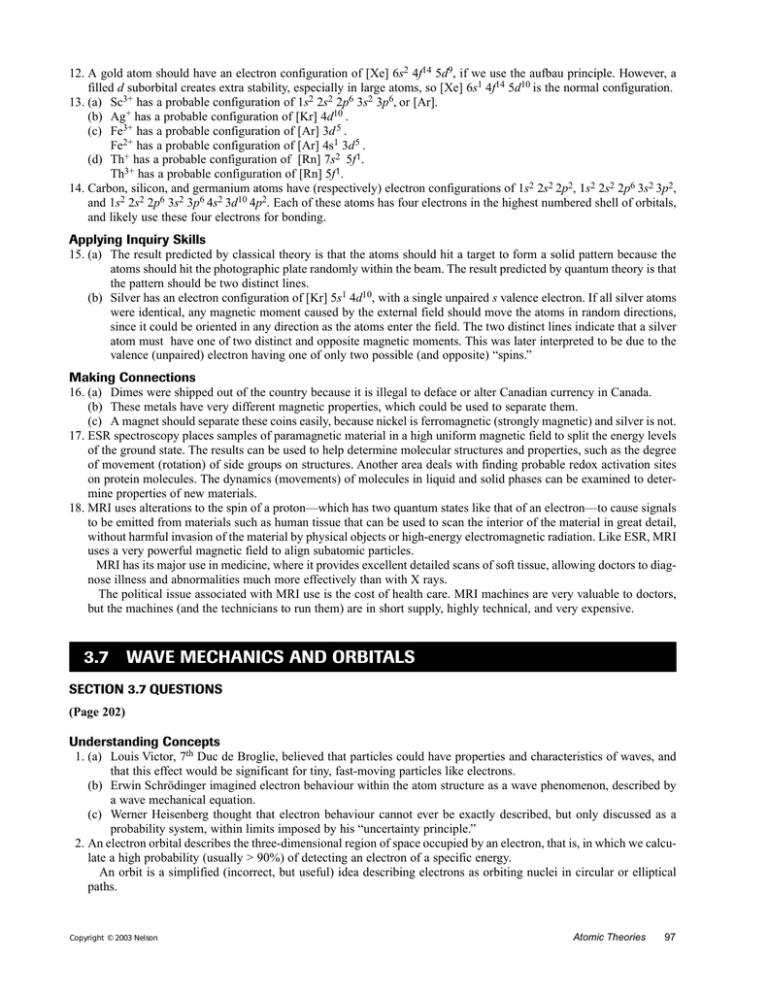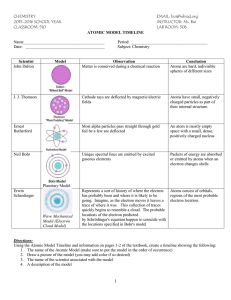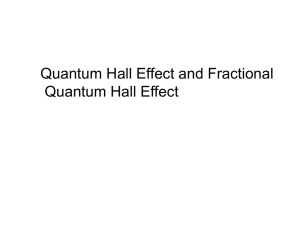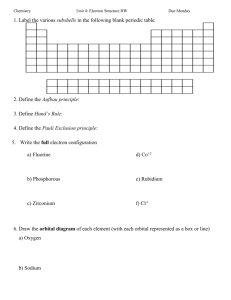s f d , if we use the aufbau principle. However, a
advertisement

12. A gold atom should have an electron configuration of [Xe] 6s2 4f14 5d9, if we use the aufbau principle. However, a filled d suborbital creates extra stability, especially in large atoms, so [Xe] 6s1 4f14 5d10 is the normal configuration. 13. (a) Sc3+ has a probable configuration of 1s2 2s2 2p6 3s2 3p6, or [Ar]. (b) Ag+ has a probable configuration of [Kr] 4d10 . (c) Fe3+ has a probable configuration of [Ar] 3d 5 . Fe2+ has a probable configuration of [Ar] 4s1 3d 5 . (d) Th+ has a probable configuration of [Rn] 7s2 5f 1. Th3+ has a probable configuration of [Rn] 5f 1. 14. Carbon, silicon, and germanium atoms have (respectively) electron configurations of 1s2 2s2 2p2, 1s2 2s2 2p6 3s2 3p2, and 1s2 2s2 2p6 3s2 3p6 4s2 3d10 4p2. Each of these atoms has four electrons in the highest numbered shell of orbitals, and likely use these four electrons for bonding. Applying Inquiry Skills 15. (a) The result predicted by classical theory is that the atoms should hit a target to form a solid pattern because the atoms should hit the photographic plate randomly within the beam. The result predicted by quantum theory is that the pattern should be two distinct lines. (b) Silver has an electron configuration of [Kr] 5s1 4d10, with a single unpaired s valence electron. If all silver atoms were identical, any magnetic moment caused by the external field should move the atoms in random directions, since it could be oriented in any direction as the atoms enter the field. The two distinct lines indicate that a silver atom must have one of two distinct and opposite magnetic moments. This was later interpreted to be due to the valence (unpaired) electron having one of only two possible (and opposite) “spins.” Making Connections 16. (a) Dimes were shipped out of the country because it is illegal to deface or alter Canadian currency in Canada. (b) These metals have very different magnetic properties, which could be used to separate them. (c) A magnet should separate these coins easily, because nickel is ferromagnetic (strongly magnetic) and silver is not. 17. ESR spectroscopy places samples of paramagnetic material in a high uniform magnetic field to split the energy levels of the ground state. The results can be used to help determine molecular structures and properties, such as the degree of movement (rotation) of side groups on structures. Another area deals with finding probable redox activation sites on protein molecules. The dynamics (movements) of molecules in liquid and solid phases can be examined to determine properties of new materials. 18. MRI uses alterations to the spin of a proton—which has two quantum states like that of an electron—to cause signals to be emitted from materials such as human tissue that can be used to scan the interior of the material in great detail, without harmful invasion of the material by physical objects or high-energy electromagnetic radiation. Like ESR, MRI uses a very powerful magnetic field to align subatomic particles. MRI has its major use in medicine, where it provides excellent detailed scans of soft tissue, allowing doctors to diagnose illness and abnormalities much more effectively than with X rays. The political issue associated with MRI use is the cost of health care. MRI machines are very valuable to doctors, but the machines (and the technicians to run them) are in short supply, highly technical, and very expensive. 3.7 WAVE MECHANICS AND ORBITALS SECTION 3.7 QUESTIONS (Page 202) Understanding Concepts 1. (a) Louis Victor, 7th Duc de Broglie, believed that particles could have properties and characteristics of waves, and that this effect would be significant for tiny, fast-moving particles like electrons. (b) Erwin Schrödinger imagined electron behaviour within the atom structure as a wave phenomenon, described by a wave mechanical equation. (c) Werner Heisenberg thought that electron behaviour cannot ever be exactly described, but only discussed as a probability system, within limits imposed by his “uncertainty principle.” 2. An electron orbital describes the three-dimensional region of space occupied by an electron, that is, in which we calculate a high probability (usually > 90%) of detecting an electron of a specific energy. An orbit is a simplified (incorrect, but useful) idea describing electrons as orbiting nuclei in circular or elliptical paths. Copyright © 2003 Nelson Atomic Theories 97 3. Quantum mechanics provides both the general shape (volume of space), and the electron probability density, within an orbital. 4. Quantum mechanics theory says nothing about either the position or about the motion of an electron within an orbital. 5. The 1s and 2s orbitals are spherical in shape, with the 2s orbital considerably larger and having two concentric regions of high probability density. A 2p orbital is shaped like a dumbbell, with two areas of high probable density, one on each side of the nucleus. 1s 2s z z z y y y x 2p x x x 2p y 2p z Making Connections 6. Statistics are used to predict situations such as the number of megajoules of electricity that will be used in a city in a given winter month, or the number of students that will achieve honours on a national examination, or the number of cases of influenza that will occur over the winter in a country. All statistical prediction is based on probability, meaning it always includes some uncertainty, and predicts better for larger samples and longer times—as does quantum mechanics. 7. Heisenberg would argue that the measured speed included uncertainty; but the amount of this uncertainty is infinitesimal for an object such as a car, certainly many orders of magnitude less than the precision of the “radar” gun. 8. Dr. Richard Bader researches the nature of atoms and bonds within molecular structures, attempting to achieve a level of understanding that will allow predictions of the properties of materials to be made by theory using computer calculations. His theory of molecular topologies is directly related to the quantum mechanics of atoms—the constituents of the structures with which he deals. 9. Areas where superconductivity is presently used include creating the very strong magnetic fields for MRI scanning (superconducting electromagnets), for magnetic shielding devices, infrared sensors, microwave signal devices, and quantum interference devices. Some projected uses are for “maglev” high-speed trains and ships, power generation and transmission, energy storage systems, high-speed particle accelerators, and precision magnetic separation devices. 10. The highest temperature at which superconductivity has been achieved is > 130 K. The substance used is a metal oxide composite (a material that has properties of a ceramic), one of a general class called peroskovites. These substances have formulas such as YBa2Cu3O7(s), the famous 1-2-3 oxide of yttrium, barium, and copper, which was the first material to superconduct at a temperature higher than that of boiling liquid nitrogen (–196 °C or 77 K). 3.8 APPLICATIONS OF QUANTUM MECHANICS Try This Activity: Bar Code Scanners (Page 205) (a) Red or white areas reflect red laser light strongly; black, dark blue, and green areas least strongly. 98 Chapter 3 Copyright © 2003 Nelson








